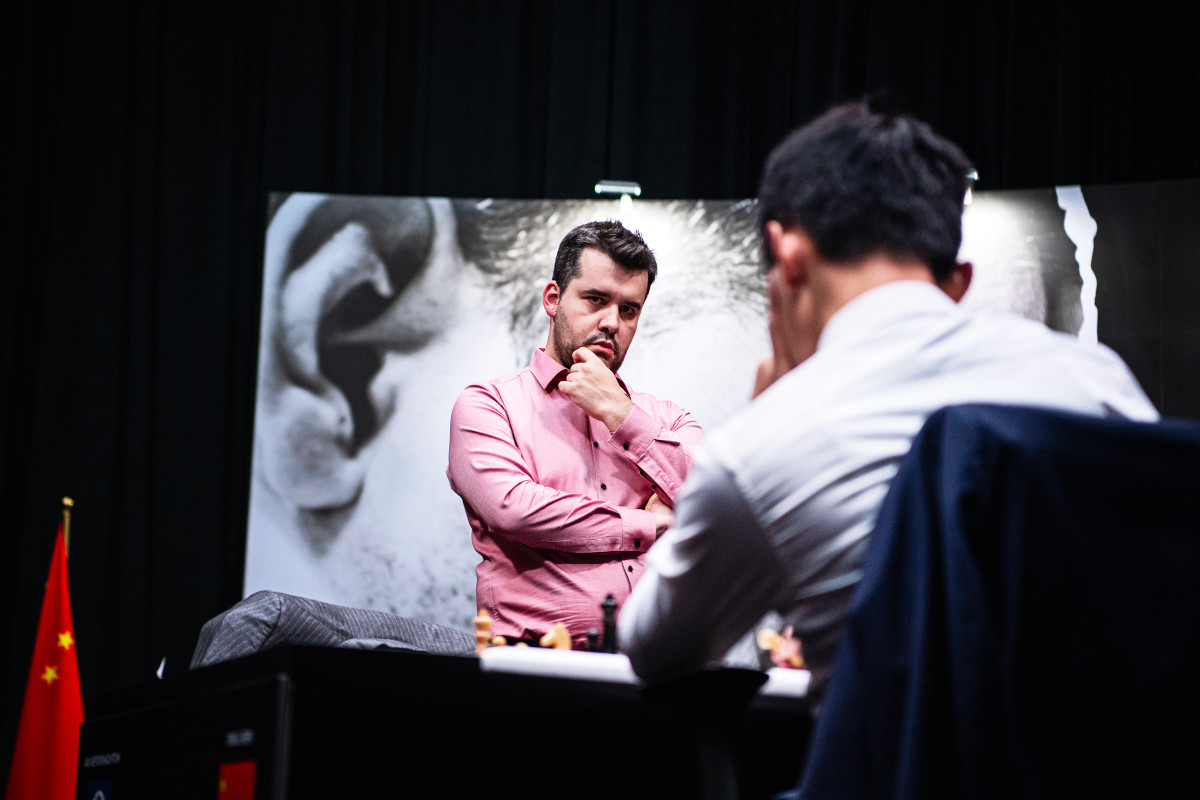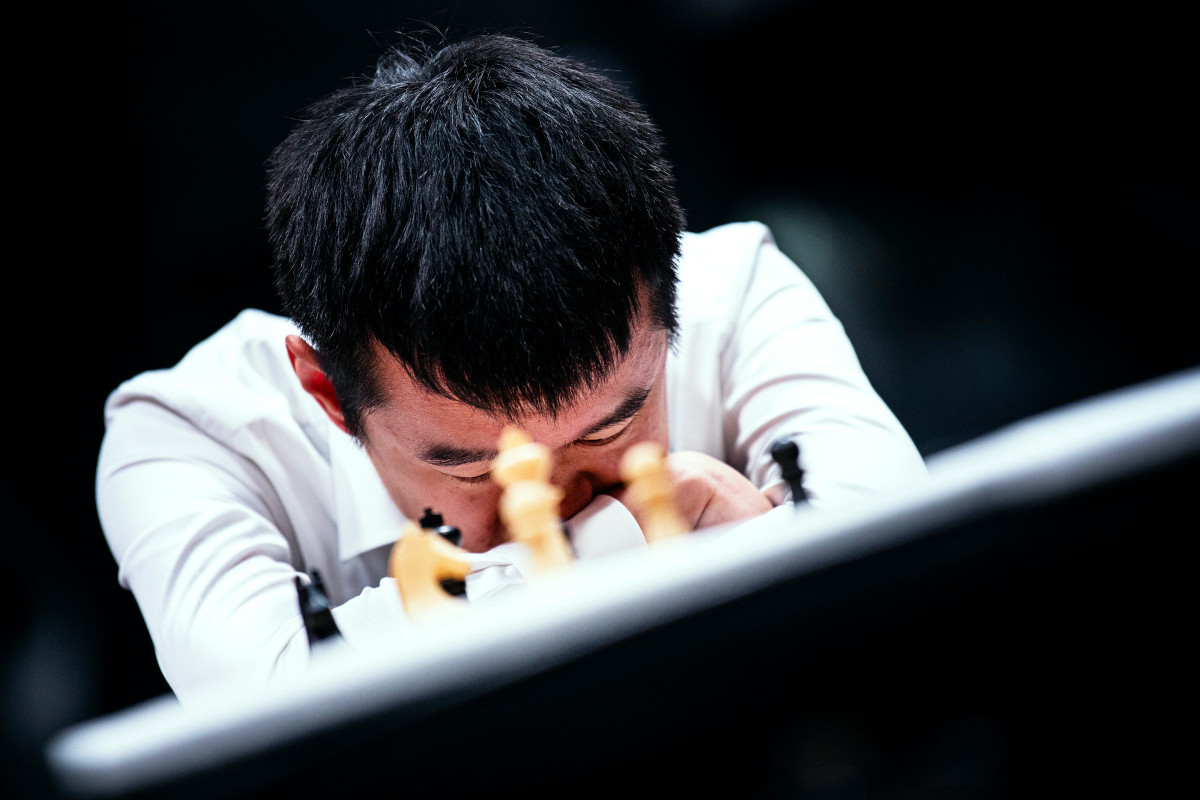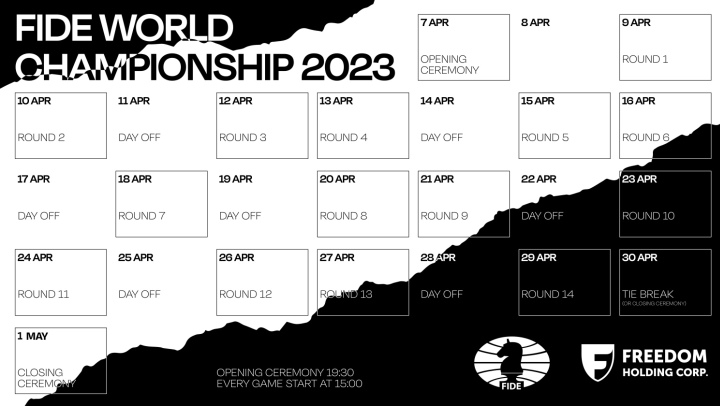


Find expert commentary — video and game annotations — by well-known coach and author IM Robert Ris at the end of the article.
The longest game played at the World Championship match in Astana before Friday’s six-hour duel had been the inaugural encounter, which lasted 49 moves. In game 9, the contenders reached the second time control (after 60 moves) for the first time in the match. Ian Nepomniachtchi got to put pressure with white, as Ding Liren played somewhat imprecisely out of the opening. But the Chinese GM managed to hold a draw in the end.
In the five games that remain to be played, Ding will get the white pieces three more times. Leontxo García asked him how he rates his chances of winning the match on a scale from one to then, to which the 30-year-old responded with a smile:
Right now it is five.

Majestic | Photo: FIDE / Stev Bonhage
Ding went for a quieter system against Nepo’s 1.e4 on Friday. The Russian did not acquiesce to playing a purely strategic battle, though, as he grabbed his chance to get the initiative on the kingside after his opponent opted for a questionable plan on the other flank of the board. At the end of the day, Ding managed to keep the balance, despite showing clear signs of disappointment throughout the game.
Commentator Daniil Dubov considered that choosing a more solid approach was the correct decision for Ding. The string of dramatic games left him down on the scoreboard despite his brilliant play in many passages of the rollercoaster encounters. With a rest day coming — and thus another chance to prepare something dangerous with white — this draw will allow the Chinese star to regain his composure before the final stretch.
As for Nepo, he did not look satisfied with the result during the post-game press conference, as he noted:
I believe it should be winning for White. At least there were some nice chances. But it wasn’t clear, and he defended well.
It has been twelve days since the match started, and the two contenders have gifted us a marvellous spectacle. Let us hope that the last five games continue to wow us. As Olimpiu Di Luppi shared on Twitter:
This match deserves a grand finale on its last stretch. pic.twitter.com/uPpl9HKCsO
— Olimpiu Di Luppi (@olimpiuurcan) April 21, 2023
Ding played the Berlin, a mainstream opening that both players have surely prepared deeply. Theory was followed until move 14, when Ding went for 14...Na6, one of three playable knight jumps in the position. Three moves later, though, it was he who made the first questionable decision of the game.
17...Rb8 is rather ambitious, preparing to capture on a4 and attack the b2-pawn. However, 17...Bf8 was called for here, both defending the kingside and leaving the c5-square vacant for the knight to be centralized.
Nepo immediately grabbed the initiative on the kingside, playing four consecutive moves on that side of the board — 18.Nh4 Bf8 19.Qf3 bxa4 20.Bxh6 Nc5 21.Ng6
Black needs to be careful here, but Ding was up to the task. Soon after, Nepo faltered by playing 23.Bg5 instead of 23.Bc4, relieving the pressure put on his opponent.
On move 27, Nepo decided not to grab an exchange, as he surprised his opponent by trading the light-squared bishops instead.
Capturing on b5 would give Black a chance to get counterplay by pushing his connected pawns on the a and b-files. Engines still consider that grabbing the rook was the best alternative for White, but Nepo’s choice to go for 27.Bxe6 Nxe6 28.Nf5 is understandable from a human point of view. After all, the knight has a strong output as it can no longer be captured by the bishop.
Ding later confessed that he was only expecting 27.Bxb5, though.
More simplifications followed as the first time control was approaching, and eventually Ding agreed to enter a rook and knight ending a pawn down. Although the endgame looked very drawish from the start, Black had to find precise moves to keep the balance even when the rooks had already left the board.
55...h3 was praised by the commentators, as disconnecting White’s pawns made things easier for Ding in defence. Nepo continued to look for chances, but from that point on it seemed unlikely that he would get anything out of such a “dry position” (Nepo).
The fourth draw of the match (in nine games) was agreed after White made his 82nd move.

“Nobody said it was easy” — Ding Liren | Photo: FIDE / Stev Bonhage

| Advertising |